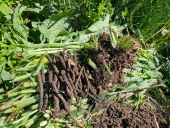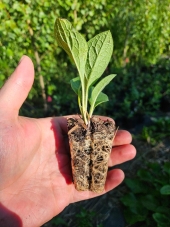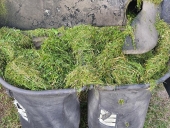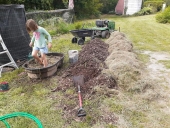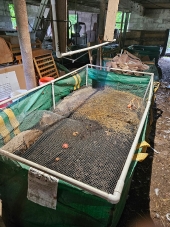Luetta Robinson wrote:Hi,
I am very interested in the silage idea as a way to feed my poultry in the winter. I have turkeys, geese, ducks, and chickens. I was wondering what your thoughts were on storing the silage in 55 gallon steel drums? I'm working on eliminating plastic from my homestead in the capacity of touching food - mine or my livestock - in any way. I have some questions...
1) Do you have to pack the container all at once, or could you add to it for,..... say, a couple of weeks to fill it as long as you added the product you mentioned between layers?
2) Do the containers of silage need to be kept warm?
3) Did the mold reverse itself or did you remove it?
4) Would this technique work with adding grass and other greens? Like dandelions, comfrey, other edible plants?
5) How much of the product do you add to how much green material?
Thank you for sharing such a great idea!
Luetta
Alaska
Thanks for the great discussion!
To answer your questions:
1.) Yes, a 55 gallon barrel would work, or a plastic pickle barrel.
The important thing is it needs to be air tight. I agree with removing plastics... I don't like buying plastic bags and then tossing them, this is more of an experiment. In the future I think I will go with a pickle barrel since I don't need to throw it away and I can roll it. These bags are really heavy to carry!
2.) I would think they would need to be kept warm.... but, I'm learning, nope!... even at 20 degrees F (-7C) they are not frozen. They are not even close to freezing on the on the edges at this temperature. They are stored in a barn, but that's open to the weather (all the windows are out, doors are off, etc.)
3.) I did not remove any mold. I am dousing it with activated Effective Microorganisms (Look up Terraganix EM) right when I make it to try to avoid mold.
4.) I would think this would work great with other greens, so long as they are not puncturing the bag, I'd also not ensile a whole bunch of one type of plant, rather, naturally pull it in. So if I'm gathering grass by my comfrey, toss the comfrey in front of the mower and bag it up. My lawn for instance is mainly grass, with maybe 10% clover and dandelions, chickory, and plantain mainly.
5.) I added about 1 1/2 gallons of activated EM I made to each contractor bag with about 4 oz EM-1, 4 oz blackstrap molasses, and the rest of the 1 1/2 gallon (40 oz) (unchlorinated) water from our well. I'd say the bag was 1/2 full so it's probably 30? gallons of grass clippings in there, at least.
I'm transitioning my property to more of a silvopasture/food forest setup, hence my interest in silage and experimentation now as we go more towards beef cattle and ruminants I'd like to use this instead of hay. The hay can get easily rained on here and with the trees, well, it won't dry too well either so I wanted a way to make feed more reliably (eventually).
Regarding the Vitamin B Deficiency some thoughts... well, one element of the EM-1 I'm introducing when ensiling the grass is brewer's yeast which is very high in Vitamin B-12, so I'm hopeful that would not be a problem. I sort of let the animals choose what to eat and give them as much variety as possible and let them figure it out. Especially with nutritional values of feeds, it's useful as a starting point but even corn is not corn; the older varieties will have more protein than modern hybrid types so I let the animals choose.
I have fed the silage to our waterfowl and they clean it up, especially in winter.
Improvements I'll be making:
1.) Use pickle barrels. This will help me roll them and protect them. It's hard dealing with a heavy bag of grass while trying not to tear the bag.
2.) (lightly) salt the silage with sea salt for minerals.
3.) It's a pain to mix the EM in while packing the bags. So instead, I will spray it on the lawn grass before ensiling it to ensure a good mix as it's being bagged. I think this would also require less EM-1 this way.
Attached is a photo of the bag dumped for the pigs a few days ago, on a 20 degree F morning.:


